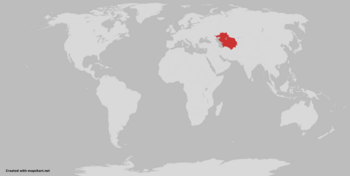Azmeny
The People’s Republic of Azmeny Azmeny | |
|---|---|
| 79 years | |
| Anthem: The Internationale | |
 A map depicting the location of Azmeny (Red) | |
| Capital | Azmenabad |
| Official languages | Azmen, Russian |
| Government | Federal Presidential Republic |
• President | Yuri Korolev |
| Legislature | Azmen National Diet |
| Establishment | 1963 (Great Patriotic Revolutionary War) |
| Population | |
• 2023 census | 80 million |
| GDP (nominal) | estimate |
• Total | $1.6 trillion |
• Per capita | $20,000 |
| Gini | low |
| HDI | very high |
| Currency | Az |
| Time zone | UTC+5 (Azmenabad standard time) |
| Internet TLD | .az |
This article is incomplete because it is pending further input from participants, or it is a work-in-progress by one author. Please comment on this article's talk page to share your input, comments and questions. Note: To contribute to this article, you may need to seek help from the author(s) of this page. |
Azmeny, officially the People’s Republic of Azmeny is a country in Central Asia. It is the region’s most populous country, with 80 million inhabitants. Azmeny is located on the eastern shore of the Caspian Sea, Azmeny’s capital and most populous city is Azmenabad, which is home to 9 million people. Other important cities include Pakhet, Altairny and Novostrashny which are all home to over 1 million inhabitants. Most of Azmeny’s large cities are located in the north and east of the country.
Azmeny was settled during the Paleolithic era, with Turkic people settling the region in the sixth century who became the precursors of the modern Azmen people. Russian settlement began on a large scale in the early 16th century, although many Russians can trace their origins back to 19th and early 20th century immigration. Throughout its history has been part of the Persian, Mongol and Russian empires until the foundation of the Sultanate of Azmenistan in 1642 by Omar I of Azmeny. The Peoples Republic of Azmeny, following a civil war which lasted 11 years, where Petr Azmanev and the Azmen Communist Union together with assistance from the USSR overthrew Sultan Ramazan.
Modern Azmeny is often considered a great power, with an industrialised economy focused on exports of grain, oil and gas as well as a successful IT sector. Azmeny also ranks highly for indicators of development such as life expectancy, human development index and levels of education, while experiencing relatively low levels of social and economic inequality. Azmeny is a member of the Collective Security League.
Etymology
Azmeny is named after the Azmen people, the main ethnic group of the country. The country was formerly known as Azmenistan from 1642-1963, when the name was changed following the Revolution. The name Azmenistan however is still commonly used to refer to the country before 1963.
Geography and Climate
Azmeny is located in Central Asia and features a continental climate, with high seasonal temperature variations and low precipitation. Azmeny experiences highs of 40 degrees Celsius, but winter temperatures can reach as low as -20. Much of central Azmeny is made of cold desert, with the Altair desert dominating the country’s interior. The south and southeast of Azmeny is highly mountainous, with the Red mountains forming the country’s borders.
Most of Azmeny’s large cities are in the cooler, less arid north or along the Azmen river, where water is more abundant and temperatures are less extreme. Additionally, most arable land is found in the east of the country, in the province of Cheskazan. Eastern Azmeny is also home to a large lake, the sea of Uran which used to irrigate farmland and provide a source of drinking water until it was contaminated by Azmen nuclear weapons testing during the 1980s.
History of Azmeny
Azmen History before 1642
Human settlement in Azmeny began during the Paleolithic era, with the regions first known inhabitants being the Saka peoples who settled the region during the 1st millennium BC, and settled along the banks of the Azmen river. During the 5th and 6th centuries, Azmeny fell under the Achaemenid Empire, and it remained under the influence of successive Persian states until the arrival of the Mongol Empire in 1220. Azmeny’s rulers adopted Persian culture, and the introduction of the Old Persian script led to the beginning of recorded history in Azmeny. The earliest mentions of the cities of Norabad, Altairny and Azmenabad can be found in the inscriptions on the ruins of Old Azmenabad, on the eastern fringes of Azmenabad province.
Azmeny was during this period divided into many disunited kingdoms, due to geography making central administration difficult for the ancient rulers of Azmeny. However, some cities such as Norabad, Azmenabad and Altairny grew wealthy due to the increase of east west trade along the Silk Road. Azmeny also progressively was settled by Turkic speaking settlers from the sixth century, who eventually outnumbered Persians and became the modern Azmen ethnic group. The Azmen gradually adopted Islam during the 9th century.
The country saw frequent invasions by the Mongol, Persian and Russian Empires throughout its history, contributing to the ethnic and cultural makeup of the country, but also preventing political unification. However, by the 16th century most of Azmeny fell under Russian control, following the eastward expansion of the Tsardom of Russia. Azmeny’s kingdoms were turned into vassals of the Russian empire, with local rulers being coerced. Many Northern Azmen converted to Christianity during this period due to an influx of missionaries from Russia
The Sultanate of Azmenistan
The Sultanate of Azmenistan was founded by Omar I in 1642, marking the creation of the first Azmen state, emerging initially as a loose confederation of Azmen tribes and nobles run under a decentralised feudal state, with the Sultan having to rely often on the private armies of the nobility to maintain power over the vast kingdom. However, following the accession to the throne of Omar’s grandson Mahmud III in 1675, Azmenistan gradually became more centralised politically under a sprawling Persian-speaking bureaucracy and a standing army. Azmenistan’s sultans also built roads to increase the connectedness of Azmeny’s furthest provinces to the capital in Azmenabad to improve political cohesion. Azmenistan also enjoyed considerable religious tolerance, as the Sultans feared political unrest if they began to take a harder line on religion.
The 17th century saw a flourishing of Azmen culture, art and architecture as the country grew progressively wealthier, and the nobility funded lavish palaces, mosques and monuments. The Royal Court also funded artisans and musicians, especially in the country’s major towns. During this period Azmenistan’s influence in the region began to rival states such as Iran and Russia, leading to some Azmen historians calling this the ‘golden age of the Sultanate’ although this has been disputed.
By 1780 however Azmenistan had declined and gradually weakened. Successive Azmen Sultans struggled to hold onto the provinces, and powerful local rulers began to take authority from the ineffectual central government. This came at the cost of Azmeny’s military strength and political autonomy, paving the way for the exploitation of Azmenistan by the British empire during the 19th century. The Kingdom of Noristan also broke free from Azmen rule, causing the country to lose territory.
The sultanate found itself caught up in the ‘Great Game’ as both Russia and Great Britain attempted to influence Azmenistan’s foreign policy and internal politics. Of particular interest to both countries were Azmenistan’s mineral deposits, especially rumours of untapped gold reserves. Britain set up infrastructure in Azmeny, but also progressively hollowed out its internal politics, turning it into a puppet state.
Oil was discovered during the 1920s in Altairny, and the Anglo-Azmen oil company was set up in 1923, exporting oil to Britain. The business however did little to enrich the sultanate, with most profits being taken to Britain, while the country grew progressively poorer and indebted. Following the end of WW2, in which the Kingdom had sent troops to support the allied war effort, the country was close to bankrupt.
The





